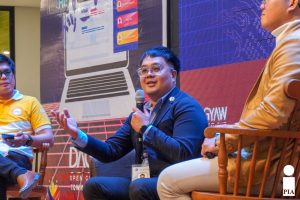CAGAYAN DE ORO CITY (PIA) — Highlighting artificial intelligence’s (AI) integration into the national fabric and its potential for economic growth, social development, and quality of life, the Department of Information and Communications Technology (DICT)-10 graced the Dagyaw 2024 of the Department of the Interior and Local Government (DILG)-10 on June 21, here.
Engr. James Sagocsoc, DICT-10 Information Officer, delivered insights into the National Innovation Agenda and Strategy Document (NASD), a visionary 10-year plan designed to position the Philippines as a regional innovation hub by 2032.
“The National AI Strategy of the Philippines is a roadmap that was developed by the DTI (Department of Trade and Industry), which envisions transforming the Philippines into an AI hub within the ASEAN region,” said Sagocsoc.
Partnering in this endeavor, the Analytics Association of the Philippines (AAP) played a critical role in shaping AI governance frameworks. Their contributions included advocating for open data policies, establishing AI standards throughout development cycles, integrating data ethics into education curricula, and promoting gender diversity within the AI industry.
In his presentation of Tungo sa Bayang Digital: How Artificial Intelligence is Transforming the Philippines’ Digital Landscape, Sagocsoc highlighted the future of AI in the Philippines. He featured the government’s strategies and roadmaps to make the Philippines one of the AI-enabled countries, unlocking economic growth, job creation, and sustainability development.
The National AI Strategy of the Philippines centers on digital transformation, infrastructure, workforce development, regulation, and research development. It is formulated to guide and govern the private sector stakeholders in employing AI technologies and developing AI economies.
Sagocsoc added that AI applications span various sectors, including agriculture, ranging from detecting crop diseases and forecasting supply chains to using AI drones for aerial surveillance. In social welfare, AI optimizes resource allocation, analyzes fraud, and assesses program effectiveness. In healthcare, AI aids in customer care through chatbots, enhances medical imaging, and analyzes electronic health records.
To realize the benefits of AI, Sagocsoc said the Philippines must address concerns such as data quality and digital infrastructure. The National Artificial Intelligence Strategy Roadmap and existing laws aim to guide private sector stakeholders in employing AI technologies. Key players include DTI, the Department of Science and Technology, the National Economic and Development Authority, DICT, the Commission on Higher Education, and the Technical Education and Skills Development Authority.
“So the overall focus is on how we can use AI to make the lives of the Filipino people better, to improve the productivity of local industries, and to enhance the competitiveness of the national economy,” said Engr. Sagocsoc.
He added that the collaborative efforts of government bodies and partner agencies align with the objectives of the national AI strategy, aiming to harness AI’s potential to uplift Filipino industries, enhance productivity, and bolster national competitiveness. “AI’s role is not to replace humans but to augment their capabilities, underscoring the importance of embracing AI to empower the workforce and ensure a sustainable digital transformation for the Philippines,” Sagocsoc said. (RTP/EZMM/PIA-10)













